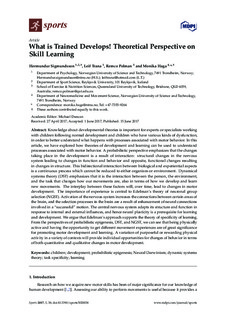| dc.contributor.author | Sigmundsson, Hermundur | |
| dc.contributor.author | Trana, Leif Magnus | |
| dc.contributor.author | Polman, Remco C.J. | |
| dc.contributor.author | Haga, Monika | |
| dc.date.accessioned | 2018-06-05T12:05:59Z | |
| dc.date.available | 2018-06-05T12:05:59Z | |
| dc.date.created | 2017-06-01T11:45:17Z | |
| dc.date.issued | 2017 | |
| dc.identifier.citation | Sports. 2017, 5 (2), . | nb_NO |
| dc.identifier.issn | 2075-4663 | |
| dc.identifier.uri | http://hdl.handle.net/11250/2500380 | |
| dc.description.abstract | Knowledge about developmental theories is important for experts or specialists working with children following normal development and children who have various kinds of dysfunction, in order to better understand what happens with processes associated with motor behavior. In this article, we have explored how theories of development and learning can be used to understand processes associated with motor behavior. A probabilistic perspective emphasizes that the changes taking place in the development is a result of interaction: structural changes in the nervous system leading to changes in function and behavior and opposite, functional changes resulting in changes in structure. This bidirectional interaction between biological and experiential aspects is a continuous process which cannot be reduced to either organism or environment. Dynamical systems theory (DST) emphasizes that it is the interaction between the person, the environment, and the task that changes how our movements are, also in terms of how we develop and learn new movements. The interplay between these factors will, over time, lead to changes in motor development. The importance of experience is central to Edelman's theory of neuronal group selection (NGST). Activation of the nervous system increases the connections between certain areas of the brain, and the selection processes in the brain are a result of enhancement of neural connections involved in a "successful" motion. The central nervous system adapts its structure and function in response to internal and external influences, and hence neural plasticity is a prerequisite for learning and development. We argue that Edelman´s approach supports the theory of specificity of learning. From the perspectives of probabilistic epigenesis, DST, and NGST, we can see that being physically active and having the opportunity to get different movement experiences are of great significance for promoting motor development and learning. A variation of purposeful or rewarding physical activity in a variety of contexts will provide individual opportunities for changes of behavior in terms of both quantitative and qualitative changes in motor development. | nb_NO |
| dc.language.iso | eng | nb_NO |
| dc.publisher | MDPI AG | nb_NO |
| dc.rights | Navngivelse 4.0 Internasjonal | * |
| dc.rights.uri | http://creativecommons.org/licenses/by/4.0/deed.no | * |
| dc.title | What is trained develops! Perspective on skill learning. | nb_NO |
| dc.type | Journal article | nb_NO |
| dc.type | Peer reviewed | nb_NO |
| dc.description.version | publishedVersion | nb_NO |
| dc.source.pagenumber | 11 | nb_NO |
| dc.source.volume | 5 | nb_NO |
| dc.source.journal | Sports | nb_NO |
| dc.source.issue | 2 | nb_NO |
| dc.identifier.doi | 10.3390/sports5020038 | |
| dc.identifier.cristin | 1473451 | |
| dc.description.localcode | © 2017 by the authors. Licensee MDPI, Basel, Switzerland. This article is an open access article distributed under the terms and conditions of the Creative Commons Attribution (CC BY) license (http://creativecommons.org/licenses/by/4.0/). | nb_NO |
| cristin.unitcode | 194,67,40,0 | |
| cristin.unitcode | 194,65,30,0 | |
| cristin.unitname | Institutt for psykologi | |
| cristin.unitname | Institutt for nevromedisin og bevegelsesvitenskap | |
| cristin.ispublished | true | |
| cristin.fulltext | original | |
| cristin.qualitycode | 1 | |

